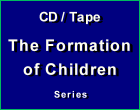Formation of Children
 |
 |
 |
 |
 |
 |
 |
The U.S. Says Goodbye to Cursive Writing
The United States is saying good-bye to cursive, a writing practice that is already in disuse and now disappearing completely from the school curriculums in 45 States. New Common Core standards have been adopted that no longer require cursive instruction, but leave it up to the district teacher to decide whether it should be taught.
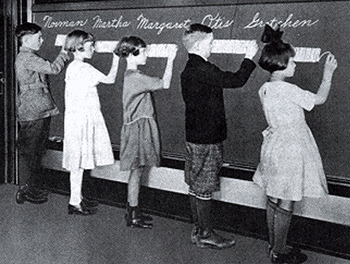 This news was considered important enough by the Vatican to be featured in an edition of its organ L’Osservatore Romano (April 8-9, 2013). Cursive is “a dying art,” explains Michael Hairston, president of the Fairfax Education Association in Virginia. Simply put, it is a traditional skill being replaced with technology.
This news was considered important enough by the Vatican to be featured in an edition of its organ L’Osservatore Romano (April 8-9, 2013). Cursive is “a dying art,” explains Michael Hairston, president of the Fairfax Education Association in Virginia. Simply put, it is a traditional skill being replaced with technology.
It serves the student better, the ruling argument goes, to offer computer and keyboarding (the modern term for typing) classes, and not waste time practicing loops and curves on paper. Cursive handwriting is not necessary for academic achievement.
Also, there is not classroom time just for it, cursive foes argue, with the curricula packed with standardized testing preparation material. Whether we like it or not, pen and paper is rapidly being replaced with computers, even in elementary schools. Moreover, in three years, all standardized tests in the U.S. will be administered electronically. Learning to write a beautiful, flowing, cursive handwriting is simply “irrelevant” in the modern world.
The Vatican organ does not make much comment, but its general disapproval is pretty clear in the closing lines of the short article. To counter this movement away from cursive, it notes, “California, Georgia and Massachusetts have wisely adopted laws to keep cursive as mandatory.”
Let me add that Idaho and North Carolina have also recently passed bills reinstating cursive writing as a requirement, and Utah, Indiana and Kansas are recommending its inclusion in curricula and studying the question further.
It is reassuring to observe that many traditional public and charter schools offer cursive, regardless of State standards. To their credit, most home-schoolers are also learning traditional handwriting, with many parents pulling out the old Palmer handwriting books I remember so well. Congratulations to them, these youth may one day be called not the Last Mohicans, but the Last Literates.
Tradition vs. practicality
Today’s proponents of cursive handwriting generally take the “practical approach” to argue their case. They point to recent studies clearly demonstrating that cursive benefits students’ motor skills and cognitive development to convince parents there are significant benefits for their children if they learn this art.
A 2012 Educational Summit titled “Handwriting in the 21st Century” hosted presentations and workshops showing how handwriting is a foundational skill that helps children develop in other areas, such as reading, writing, memory, and critical thinking. One of the most remarkable findings came from presenter, Karin Harman-James, whose research proved that writing by hand activates parts of the brain associated with language development, while keyboarding does not.
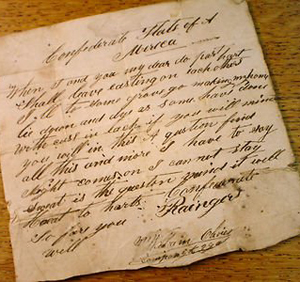 I suppose that the practical, scientific approach is the only one that yields results in the modern world. But for me, the aesthetics argument is stronger. In a world becoming increasingly ugly and more vulgar by the day, a fine cursive hand offers relief. Handwriting reveals not only a person’s personality and character, but the culture of a people.
I suppose that the practical, scientific approach is the only one that yields results in the modern world. But for me, the aesthetics argument is stronger. In a world becoming increasingly ugly and more vulgar by the day, a fine cursive hand offers relief. Handwriting reveals not only a person’s personality and character, but the culture of a people.
A beautifully crafted handwritten letter is a work of art, a kind of music on paper. I am always amazed when I look at old Civil War letters and see the elaborate, elegant handwriting of simple soldiers, who took care to present themselves well in their writing. That is because a man’s or woman’s writing meant something, it represented who and what the person was. It was not just the hasty, artless scrawling that we see today, when indeed, we even see a letter or the written word, since that is fast becoming a habit of the past…
It was shocking for me to learn that there is a generation of youth today who can barely decipher script writing. I recently heard about an 11-year-old girl who could not read the handwritten note from her grandmother on her birthday card because it was in cursive. It was only when I started doing research for this article that I realized her case was not unique or unusual.
A university professor reported that on a whim she asked an English class how many students wrote in cursive. No hand raised. Some admitted they barely remembered how to read cursive, much less write it. Most said that when they write, they write in capital letters. One girl related how she and her cousin had leafed through their grandmother’s journal shortly after she died, but had difficulty deciphering her cursive handwriting. “It was kind of cryptic,” she said.
Even the signatures of many youth are no longer in cursive. One student, a freshman at Central Arkansas who always signs her name in all capital letters, said this posed a problem at a college entrance exam, which required a cursive signature. “Some people in there couldn’t remember how to do it,” she said. “I had to think about it for a minute. It was kind of hard for me to remember.”
An illiterate generation
Practicality and aesthetics aside, it seems to me there is a more pressing reason to insist on a return to cursive handwriting. It is a question of literacy.
 Literacy is defined as the ability to read fluently, write coherently and think critically about a shared language. The inability to do all of the above is called illiteracy. I believe we are fast approaching this sad state of analphabetism in a world that boasts of technological progress.
Literacy is defined as the ability to read fluently, write coherently and think critically about a shared language. The inability to do all of the above is called illiteracy. I believe we are fast approaching this sad state of analphabetism in a world that boasts of technological progress.
This generation that can barely or no longer read the letters of their parents and grandparents is sinking quickly into barbarianism. The cultivated word, product of a developed civilization - one might say another remnant of Christian Civilization - is being replaced by internet jargon and teen ‘chat lingo.’
This language is as indecipherable to many in the older generations, including this writer, as our cursive handwriting is to the youth.
Were I to receive a text message like this - nvm TTYL TC - I would have no idea what was being said. BTW (By the way), it translates like this: Never mind. Talk to you later. Take care.
There is a Webopedia Quick Reference list of text abbreviations to help newcomers to the language translate the lingo, and a special guide for confused parents of teenagers to decipher their messages, which often abbreviate vulgar and even profane words as a matter of course.
It is a generational divide that speaks to me not of progress, but a regression back to a primitive way of writing, thinking and being.

Posted May 15, 2013

The disciplined Palmer method taught in old Catholic schools has long been replaced by a casual script, below
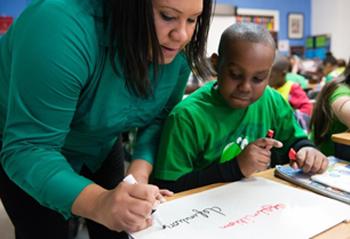
It serves the student better, the ruling argument goes, to offer computer and keyboarding (the modern term for typing) classes, and not waste time practicing loops and curves on paper. Cursive handwriting is not necessary for academic achievement.
Also, there is not classroom time just for it, cursive foes argue, with the curricula packed with standardized testing preparation material. Whether we like it or not, pen and paper is rapidly being replaced with computers, even in elementary schools. Moreover, in three years, all standardized tests in the U.S. will be administered electronically. Learning to write a beautiful, flowing, cursive handwriting is simply “irrelevant” in the modern world.
The Vatican organ does not make much comment, but its general disapproval is pretty clear in the closing lines of the short article. To counter this movement away from cursive, it notes, “California, Georgia and Massachusetts have wisely adopted laws to keep cursive as mandatory.”
Let me add that Idaho and North Carolina have also recently passed bills reinstating cursive writing as a requirement, and Utah, Indiana and Kansas are recommending its inclusion in curricula and studying the question further.
It is reassuring to observe that many traditional public and charter schools offer cursive, regardless of State standards. To their credit, most home-schoolers are also learning traditional handwriting, with many parents pulling out the old Palmer handwriting books I remember so well. Congratulations to them, these youth may one day be called not the Last Mohicans, but the Last Literates.
Tradition vs. practicality
Today’s proponents of cursive handwriting generally take the “practical approach” to argue their case. They point to recent studies clearly demonstrating that cursive benefits students’ motor skills and cognitive development to convince parents there are significant benefits for their children if they learn this art.
A 2012 Educational Summit titled “Handwriting in the 21st Century” hosted presentations and workshops showing how handwriting is a foundational skill that helps children develop in other areas, such as reading, writing, memory, and critical thinking. One of the most remarkable findings came from presenter, Karin Harman-James, whose research proved that writing by hand activates parts of the brain associated with language development, while keyboarding does not.

The elegant script of a civil war soldier writing his fiance
A beautifully crafted handwritten letter is a work of art, a kind of music on paper. I am always amazed when I look at old Civil War letters and see the elaborate, elegant handwriting of simple soldiers, who took care to present themselves well in their writing. That is because a man’s or woman’s writing meant something, it represented who and what the person was. It was not just the hasty, artless scrawling that we see today, when indeed, we even see a letter or the written word, since that is fast becoming a habit of the past…
It was shocking for me to learn that there is a generation of youth today who can barely decipher script writing. I recently heard about an 11-year-old girl who could not read the handwritten note from her grandmother on her birthday card because it was in cursive. It was only when I started doing research for this article that I realized her case was not unique or unusual.
A university professor reported that on a whim she asked an English class how many students wrote in cursive. No hand raised. Some admitted they barely remembered how to read cursive, much less write it. Most said that when they write, they write in capital letters. One girl related how she and her cousin had leafed through their grandmother’s journal shortly after she died, but had difficulty deciphering her cursive handwriting. “It was kind of cryptic,” she said.
Even the signatures of many youth are no longer in cursive. One student, a freshman at Central Arkansas who always signs her name in all capital letters, said this posed a problem at a college entrance exam, which required a cursive signature. “Some people in there couldn’t remember how to do it,” she said. “I had to think about it for a minute. It was kind of hard for me to remember.”
An illiterate generation
Practicality and aesthetics aside, it seems to me there is a more pressing reason to insist on a return to cursive handwriting. It is a question of literacy.

A generation of texters 'writing' in a new and primitive language
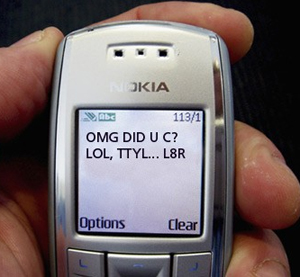
This generation that can barely or no longer read the letters of their parents and grandparents is sinking quickly into barbarianism. The cultivated word, product of a developed civilization - one might say another remnant of Christian Civilization - is being replaced by internet jargon and teen ‘chat lingo.’
This language is as indecipherable to many in the older generations, including this writer, as our cursive handwriting is to the youth.
Were I to receive a text message like this - nvm TTYL TC - I would have no idea what was being said. BTW (By the way), it translates like this: Never mind. Talk to you later. Take care.
There is a Webopedia Quick Reference list of text abbreviations to help newcomers to the language translate the lingo, and a special guide for confused parents of teenagers to decipher their messages, which often abbreviate vulgar and even profane words as a matter of course.
It is a generational divide that speaks to me not of progress, but a regression back to a primitive way of writing, thinking and being.

Posted May 15, 2013
______________________
______________________






